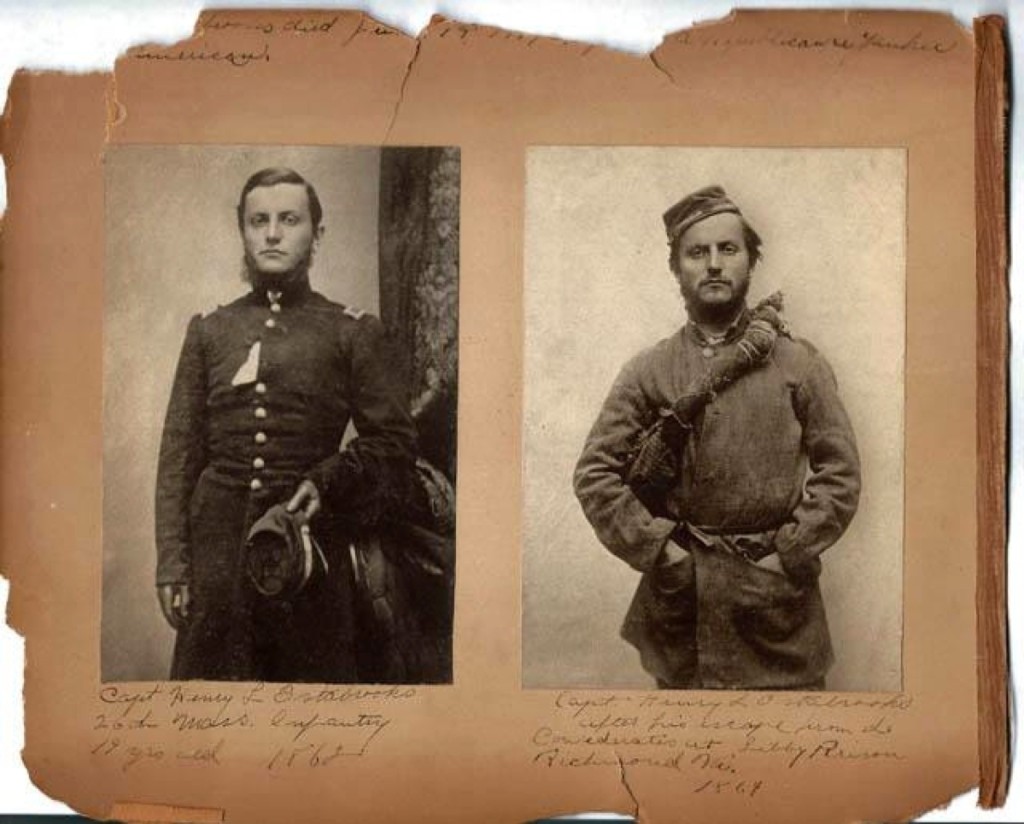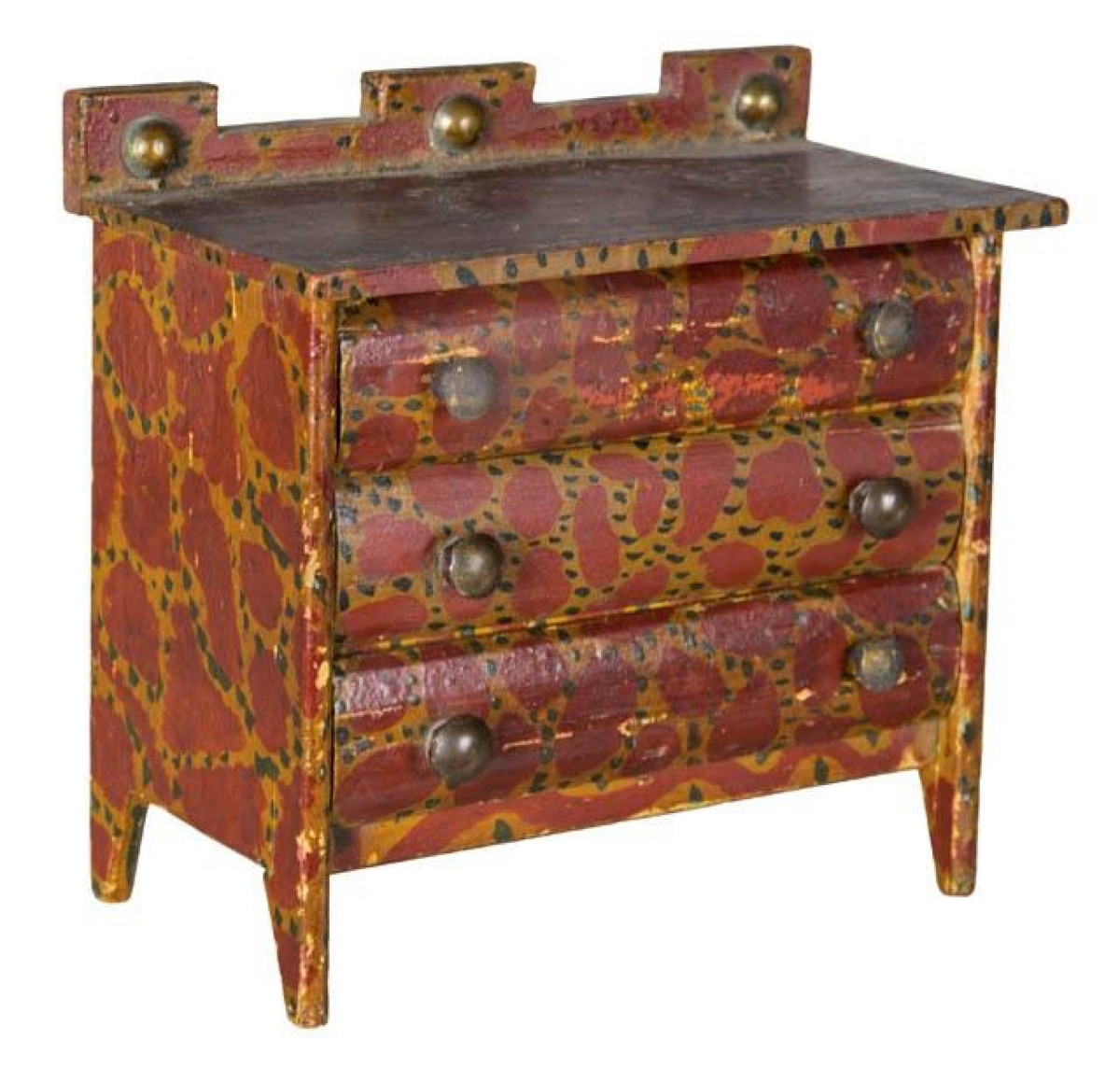
These photographs accompanied the Estabrooks manuscript and show him in uniform and in the clothes provided to him by the slaves who assisted him.
Review and Onsite Photos by Rick Russack, Additional Photos Courtesy Willis Henry
PLYMOUTH, MASS. – Willis Henry’s sale on April 14 firmly demonstrated the strength of the market for woodenware, particularly those made in Hingham, Mass. Approximately 100 bidders in the room competed with an active internet and several phone lines. While there were some bargains to be had, interest in Americana, including redware and stoneware, was strong. The sale included two exceptional items, a very unusual family record, and a rare Civil War manuscript. Both seemed reasonably priced. Most of the lots in the sale were from local, south shore estates and the sale grossed $191,610.
The Civil War manuscript went to the Massachusetts Historical Society, for $4,560. It had been written by Captain Henry L. Estabrooks, who served with the 2nd Massachusetts Infantry during the Civil War. His regiment saw action at Gettysburg, Antietam, Atlanta and in other major battles. He was captured by the Confederates and sent to Libby prison, in Richmond, Va. In 1864, Estabrooks escaped from the prison train and later wrote about the escape and journey back to Union lines. His manuscript was published in 1866 under the title Adrift in Dixie. It recounts his escape from the train and how he traveled from plantation to plantation under cover of darkness and how he was assisted by plantation slaves, who fed, clothed and directed his travel. Estabrook’s book remains in print today, having been reprinted as recently as 2016. Willis Henry had Estabrook’s original 132-page manuscript, which Estabrook had titled Account of Last Two Months Service in US Army by H.L. Estabrook, 1864. The manuscript was in very good condition, easily read, and, most importantly, included pencil sketches, some in color, that had never been included in any of the published versions of the story. Included with the manuscript were two albumen photographs; one showed Estabrooks in his Union army uniform, the other showing him in the clothes he had been given by the slaves who helped him.
The auction also included a very unusual early Nineteenth Century watercolor family record, which might have been called unique, were it not for the fact that at least two others are known to exist. The unsigned work documents seven generations of the family of Mathew Cushing, who settled in Hingham, Mass., in 1638. It is drawn in the form of a leafy tree, with numerous branches, each of which gives the name and dates of various descendants of the family. In the background is Hingham harbor with a three-masted schooner and four men in a rowboat. Two Native Americans crouch behind rocks on the shore watching the arrival of the boat. Birds fly overhead. A phone bidder paid $4,560 for this one. Henry said that he is aware of two other very similar family records, also relating to Hingham. After the sale, folk art specialist Joan Brownstein was asked if she had seen similar examples. Her response: “I’ve never seen one.” The group would seem to be worth the time of an experienced folk art researcher. The family record descended in the Lincoln family of Hingham, and a portrait miniature of Francis Henry Lincoln sold for $1,080.
Staying with the Hingham theme, the sale included firkins and miniature woodenware made in that town, which was also known as “Bucket town.” Prices were strong, topped by a miniature pine firkin carved from one piece of wood. It retained the original dark green paint and had been scored on the sides to represent staves. It was 4ý inches tall and finished at $7,200. A lot of two full-size firkins, both in old red, one lettered “Oatmeal” and the other lettered “Sugar,” realized $5,040. Both had well-worn surfaces, one had a mouse hole in the cover and both had the letter “M” on the cover in a fancy script. According to Henry, that letter indicated that they had been owned by the Minott family. One also had the letter “H” on the bottom, indicating that it had been made by a member of the Hersey family of Hingham.

One of the major surprises of the day was this miniature pine bureau, 5¼ inches tall, which had been found in Vermont. It was decorated with red paint and exceptional snake-like graining over the red. The drawer fronts were beveled, and it had a rectangular backsplash. It was estimated at $1,400. A phone bidder competed with an internet bidder until it sold for $6,900 to the phone bidder.
Other painted furniture and smalls did well. Surprising everyone, including Henry, was a miniature pine bureau. It was finished in original red paint with exceptional web-like graining, a cut-out backsplash and beveled drawer fronts. A phone bidder competed against the internet until the phone bidder was successful, paying $6,900. A small four-drawer chest, with an old red finish over blue, marked “JB 1742” on the bottom, fetched $3,300. It had been bought at a Chris Snow auction in 1974. A dry sink, with mustard paint, which had been owned by well-known Shaker dealer Ed Clerk, earned $2,520 against a $500/700 estimate. An early Nineteenth Century hanging cupboard, in original red paint with a carved wood spring-held latch, sold to an internet bidder for $960, while a small grain-painted storage box, lettered “LLH” in gold on the cover, went for $1,800, more than four times the estimate. An Eighteenth Century butter churn with rose-head nails, a carved piggin handle and original yellow-green paint, brought $780.
When a lot early in the sale brings about 15 times its estimate, it can set the tone for the sale. That’s what happened when a group of four early bottles – the sixth lot in the sale – sold for $4,500. One of them, a dark green medicine bottle embossed “Pike & Osgood, Boston, Mass” and “Alterative Syrup,” 8ý inches tall, was exceptionally rare. It is interesting to note that Norman Heckler had at one time sold one for $10,530, and, according to his website, the bottle, which Heckler deemed “rare,” was made at the Stoddard, N.H., glasshouse between 1846 and 1860. Henry also had a wide selection of redware and stoneware. With condition issues, some were sold in lots with multiple pieces. Some rare redware was included. One lot, of five pieces, included a rare Illinois jug. According to redware scholar Justin Thomas, who was not at the sale but who commented afterwards, it was a “Nineteenth Century slip-decorated red earthenware jug from Galena, Ill., that had been damaged on the handle. Similar jugs from Galena, but in perfect condition, have sold for $6,900 and $8,050, in recent years. This particular lot seemed fair when it brought $2,760.” Thomas also liked a “real nice Essex County, Mass., or northern New England jug.” It was cataloged as light green glaze with orange underglaze, and it sold for $960, despite a small crack at the lip. Four spongeware pitchers, each about 9 inches tall, each with damage, sold for $240, and a lot of three spongeware butter crocks, one without a cover, went for $210.
A group of paintings by Charles Henry Gifford (American, 1839-1904) may have been good buys. Selling for less than the estimate, Gifford’s oil of a lightkeeper’s house on a rocky ledge, with a full moon and fishermen in boats, brought $2,400. It was marked on the stretcher “Grand Manan” which is an island off the coast of New Brunswick. Four other paintings by the artist sold between $840 and $1,800. An unusual sea scallop shell painted with a shoreline scene with a sailboat and house, went out for just $300. Gifford paintings often sell in the $4/6,000 range and some of his work has brought five-figure prices. Henry noted that this group of Giffords had come from the estate of Ernie Sattler and been bought “back when no one cared.”
After the sale, Henry commented on the numerous purchases by internet bidders. “It has me thinking that perhaps we should try timed, online-only sales the way some other guys are doing. I was surprised at some of the prices, like that little miniature chest that brought almost $7,000, and I was glad that some of the stuff wound up where it should. The Civil War manuscript is an important piece and it belongs in the historical society.”
All prices include the buyer’s premium as reported by the auction house. For additional information, 781-834-7774, or www.willishenryauctions.com.






















